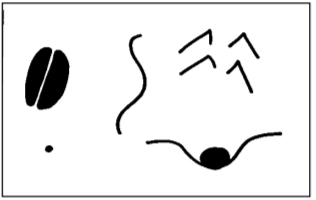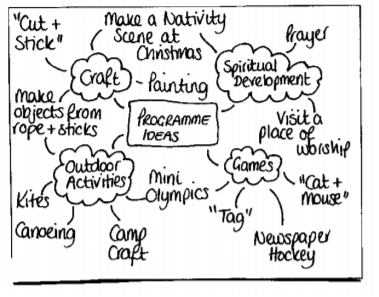Generating ideas
Every day we have to come up with ideas for what to do about something. 'What shall we have for dinner?' or 'How shall we encourage more young people to join Scouting?'.
Sometimes we can get stuck at just a couple of ideas and other times we have so many and no way of recording them all.
An important point to remember if you are using diagrams to aid your idea generation is that once the diagram is so complex that it is no longer clear, it's better to split it onto more than one diagram.
Creative thinking
When you are trying to determine the alternatives that lie before you, it's important to recognise the value of creative thinking. It can be possible to discover ideas and alternatives that never would have even occurred to you using conventional methods.
Even though this is widely recognised as being true, as adults we are not often encouraged to be wildly imaginative. As a result, creative thinking, when faced with a task or problem, may seem nigh on impossible!
It's important to be relaxed before approaching a task such as generating ideas. If you are working alone, then things such as doing a crossword, painting, or relaxation exercises may help. However, working with a small group can be extremely helpful in encouraging your ideas to flow, because other people’s comments may trigger useful thoughts in you.
When working with a small group, it's important to encourage all the members to think freely. Small games or exercises before tackling the main task can help with this. For example:
- You could ask members for twenty things you can use a paperclip for.
- Before the meeting you could splash paint onto a page and fold it to create an “ink blot” and then ask the members to suggest what pictures can be imagined in them.
- You could also draw some shapes (such as the ones below) on a blackboard or flipchart and ask the group what they could be.

Visualising the future
This requires the ability to think about the point you wish to reach, or what the situation would look like without the problem you are trying to solve. You need to think to the future and visualise a picture of how things will be. Ask questions such as “What would be happening?”, “Which people are involved?”, “What will money be spent on?”, What resources will be needed?”.
Once you have a mental image of the future would look like, work backwards and think about what needs to be done in order to get to that point.
Mind maps
When you construct a mind map, you begin in the centre with a phrase that describes your main theme or subject. Then you branch out with each subtheme, and then branch out from that with “sub-subthemes”, and so on, until you have as many details as you can think of that link (directly or indirectly) to the main theme.
The advantages of writing your ideas out in this way are that:
- The main theme is clear.
- Links between ideas can be easily shown and recognised (for example, the Mini Olympics idea could relate to either “Outdoor Activities” or to “Games” or both).
- This structure stimulates ideas better than linear note-taking because it helps the brain make new connections.
- It allows additions to any area.
Instead of using words (as in the example), you could draw pictures to represent your ideas, or more likely, a mixture of both. It is quite likely that you will find this helpful if you're able to make quick sketches, however if your talent does not lie in drawing, then it could prove to be more of a distraction than help.

Relevance trees
An alternative form of mind maps with many of the same advantages is the relevance tree. Originally these were developed for managing research, but can equally be used to stimulate ideas.
Which form you choose will very much depend on your style of work. The “classic” mind map is very free and quite creative, but the relevance tree is a more ordered / structured way of noting down ideas. The disadvantages of this method are that the width of the page limits the number of branches possible, and that the more formal appearance may stifle creativity.
Brainstorming
Brainstorming generally happens as a small group of people, who have varying amounts of knowledge about the subject under discussion. All ideas are recorded, no matter how bizarre.
The aim of brainstorming is to stimulate interest and discussion quickly from the group’s existing knowledge.
No member of the group should know what is to be discussed before the meeting. The leader of the group should announce the subject and give members about 5 minutes to think about it and make notes individually.
Then each person gives an idea in turn, and the leader writes it down. No idea should be laughed at, and all should be written down and considered. This should stimulate more ideas from the group than they first thought of.
Once ideas are no longer forthcoming, then the ideas should be classified under suitable headings, and then the work of sorting and selecting the most promising ideas can begin.
